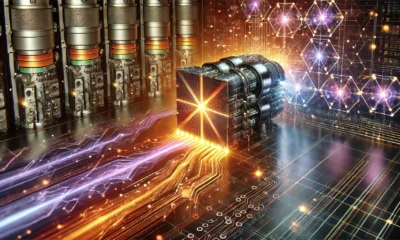Artificial Intelligence
How AI is Reconstructing Construction: From Pre‑Design to Predictive Maintenance

The construction industry is in the midst of a profound transformation. Traditionally slow to digitize, it is now embracing artificial intelligence (AI) across every stage, from early design to long-term asset maintenance. This shift is redefining how projects are planned, built, and sustained. The rise of AI in construction spans multiple dimensions: optimizing design, enhancing site safety, improving project predictability, and enabling smarter, more sustainable buildings.
For decades, construction was defined by manual tasks, paper drawings, and fragmented data silos. Complex logistics, distributed stakeholders, and a labor-intensive culture contributed to minimal technology adoption. The industry relied heavily on human intuition and experience to manage risks, often leading to cost overruns and delays.
So, what’s changed?
Rapid advances in AI, machine learning, computer vision, cloud computing, and mobile connectivity have catalyzed a wave of digital transformation. Many AI tools are now built specifically for construction workflows, enabling automation and data-driven decision-making that was once impractical. The global AI in construction market is projected to grow at a compound annual growth rate of over 20% through 2030, reaching more than $22 billion USD. Roughly 35% of construction firms have adopted at least one form of AI, and 70% of large projects now include some AI-driven component. These tools are delivering real results, from cost reductions of up to 20% in project planning to measurable improvements in safety and efficiency.
On job sites, AI is already reshaping how work gets done. Safety monitoring and risk prediction systems powered by computer vision can detect hazards such as missing PPE, unsafe proximity to machinery, and potential fall risks. In fact, firms are now relying on AI to aggregate weather, personnel, and task data to forecast safety incidents across workers, flagging risks like insufficient supervision. Emerging Vision-Language Models such as GPT‑4o and Gemini now demonstrate high hazard identification accuracy–scoring BERTScore ~0.90–though real-time implementation remains challenging.
Autonomous equipment and robotics are also making their mark. Companies like Built Robotics retrofit heavy equipment such as excavators and bulldozers for autonomous excavation and grading. Robots are performing tasks like bricklaying, drywall installation, surveying, and demolition, often with precision that exceeds human performance. Productivity gains of 20–22% and material waste reductions of up to 30% are being reported. In the UK, bricklaying robots are being trialed to assemble facades using dual-arm systems that can lay roughly 500 bricks per shift with minimal supervision.
Predictive scheduling and budget forecasting powered by machine learning are also gaining traction. By incorporating variables such as weather patterns, labor availability, supplier lead times, and live site progress, these tools can reduce planning errors by up to 20% and improve scheduling accuracy by 35%.
Quality assurance has seen similar benefits. AI-powered drones and stationary cameras perform inspections at speeds up to three times faster than manual checks, detecting misalignments or material defects with nearly 90% accuracy. Early detection of defects reduces rework and prevents costly downstream errors, improving both efficiency and safety.
Beyond the job site, AI is transforming the design and planning phase. Generative design platforms now evaluate thousands of permutations under constraints like structural integrity, cost limits, and sustainability goals. This accelerates the creation of optimized solutions that human designers might overlook. Case studies have shown AI can reduce tender analysis times and surface critical safety optimizations in large-scale infrastructure projects. Integration with Building Information Modeling (BIM) platforms allows AI to automate clash detection, simulate construction sequences, and estimate resource usage. These capabilities improve coordination accuracy by 30%, cut estimate errors by 25%, and reduce manual planning workloads.
Workforce augmentation is another critical dimension. AI is not eliminating skilled trades; instead, it is changing the nature of their work. Robots handle repetitive or hazardous tasks–like excavation and heavy lifting–while humans focus on craftsmanship, complex assemblies, and finishing. Pilot programs emphasize that skilled oversight remains essential, particularly in modular construction and micro-factory workflows.
As AI proliferates, digital literacy and new skillsets are becoming indispensable. Workers now benefit from training in data interpretation, human-machine collaboration, and even prompt engineering for AI tools. Virtual and augmented reality training simulations, along with AI-based safety modules, have been shown to improve compliance rates by 20–40% and roughly 60% of firms now invest in AI upskilling initiatives.
However, challenges remain. Safety monitoring often involves wearable sensors, cameras, or GPS tracking, raising valid concerns about privacy and surveillance. Broader adoption also introduces cybersecurity and data ownership issues, as sensitive project and personnel information resides on cloud-connected devices. Ethical considerations include job displacement, transparency in automated decisions, liability for AI errors, and maintaining worker trust . Legacy system integration also presents hurdles, as many firms still rely on paper-based workflows and disconnected software tools, requiring careful change management for full AI implementation.
Looking ahead, AI will play a central role in developing smart cities and infrastructure. Traffic-responsive roads, energy-aware street lighting, and predictive maintenance for bridges and utilities are becoming feasible. Early AI integration in new developments can prevent expensive retrofits later, as shown in Australian urban pilots where smart poles and sensors improved both safety and pedestrian traffic. Sustainability is another frontier: AI-driven HVAC optimization in a Manhattan tower cut energy use by approximately 15.8%, saving $42,000 annually and reducing emissions by 37 tons of CO₂. Combined with generative design and modular building, these advances point toward large-scale decarbonization.
Artificial intelligence is advancing from the margins to the mainstream of the construction industry. Its influence spans pre-design optimization, job site safety, workforce collaboration, and long-term sustainability. While privacy, ethics, and legacy integration remain challenges, the trajectory is clear: firms using AI are reporting efficiency gains, risk reduction, and measurable environmental benefits. As adoption rises from roughly 35% of firms toward saturation, a smarter, safer, and more sustainable built environment is not just possible–it is imminent.












